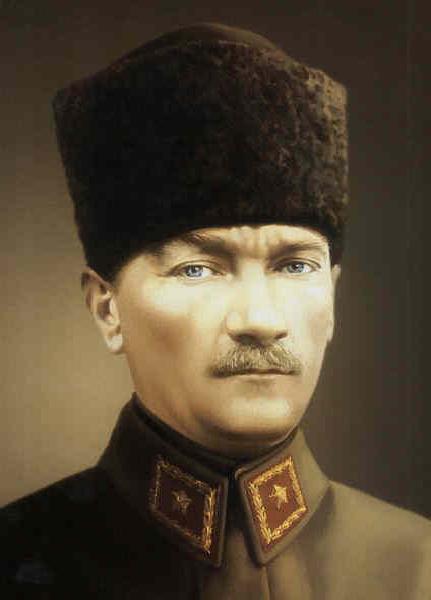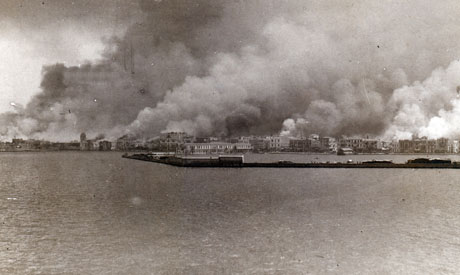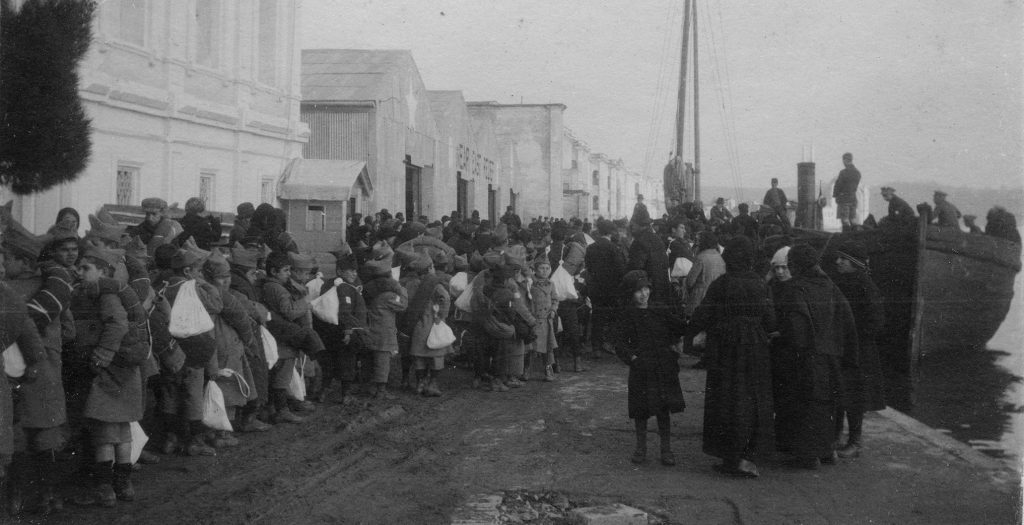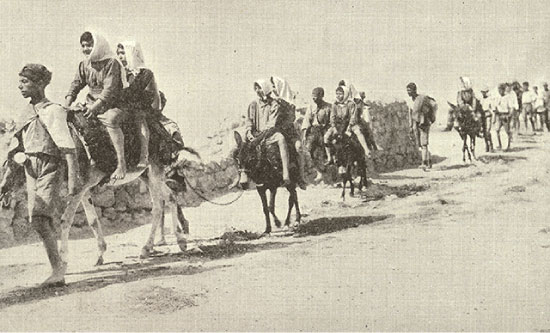An Unimaginable Tragedy on the Coast
Map of the Anatolia Region.
As WWI drew to a close in 1918, leaders from 27 countries gathered for the Paris Peace Conference. The Allies began divvying up Ottoman territory and decided the city of Smyrna should be occupied by the Greek army. This foreign occupation of the former Ottoman Empire, along with the call for Turkey to recognize Armenia as an independent state, sparked the rise of Turkish nationalism throughout the region. The Turkish military, led by Mustafa Kemal, launched a war of independence against Greece, seeking to regain lands lost following WWI.

Left: New York Times headline announcing the Greek occupation of Smyrna following the Paris Peace Conference.
Smyrna (now Izmir, Turkey) was one of the cities the Turkish army fought to regain during the Greco-Turkish war. Positioned on the west coast of the Anatolia region of modern-day Turkey, Smyrna was a strategic location for both the Greeks and the Turkish due to its status as a port city.

Right: Mustafa Kemal Pasha led the Turkish nationalist movement following the collapse of the Ottoman Empire following its defeat in WWI. Kemal later became the first president of the Republic of Turkey in 1923 and served until his death in 1938.
In addition to the strategic appeal of Smyrna, the city was important to the Turkish for historic and cultural reasons as well. A sight of major contention over the years, Smyrna had been occupied off and on for the vast majority of its history. By the Greco-Turkish war, the Greek and Armenian population outnumbered Ottoman Turks two to one, angering the local Turkish ruling population and increasing the desire for the nationalist army led by Kemal to retake the region back and restore it to Turkish rule.

Map showing the different quarters of Smyrna, 1922
Suffering defeat after defeat, the Greek army withdrew from Smyrna in 1922. On September 9, 1922, the Kemalist army entered the city to reassert control and remove the lingering Greek presence. As the Greek army presence waned, the remaining Greek and Armenian inhabitants were increasingly targeted by the Turkish army.
On September 13th, tragedy struck. Beginning in the Armenian quarter of the city, the Great Fire of Smyrna, as it would later become known, quickly spread. The chaos and panic that ensued is difficult to imagine. While sources differ about the true cause of the fire, the devastating effects that were captured by firsthand accounts of relief workers as well as in haunting photographs are indisputable.

A ship passing in front of Smyrna as the city burns in the background.

A view of Smyrna burning from coast.
Faced with another refugee crisis as tens of thousands of Greeks and Armenians fled to the coast, Near East Relief was called into action once again.
Refugees fled to the coast as the city was destroyed behind them.

The day of the fire, H.C. Jaquith, Managing Director of Near East Relief in Constantinople, went to Smyrna, taking with him a ship of emergency supplies. All of the Near East Relief supplies in Smyrna had been destroyed in the fire that consumed two-thirds of the city. This made evacuation the only possible solution. NER orphanages in Constantinople sent supplies of flour, rice, beans, and milk when possible to feed the survivors at Smyrna. Meanwhile in the United States, NER’s emergency fund was being used to gather more supplies for Smyrna and to replenish the supplies being sent from Constantinople to prevent the depletion of their resources as well.
Left: Portrait of H.C. Jaquith
To learn more information about H.C. Jaquith.
While supplies were gradually being restocked, Smyrna had to also face unsanitary conditions that caused widespread outbreaks of cholera and smallpox. As a result, the water in the city was cut off while deportations to Greece and further into Turkey continued to occur. There were many instances reported where refugees waiting to be evacuated died of exhaustion, went insane, committed suicide, or feared going further into an area where they would be in a different type of danger, such as possible further persecution from the Turkish forces.

Refugees wait to be rescued on the docks of Smyrna. Image courtesy of the Armenian Genocide Memorial-Institute.
Amidst the chaos, Dr. Esther Lovejoy of the American Women’s Hospital delivered infant after infant into the harsh environment of Smyrna. The survivors became entirely dependent on the American relief workers who were rationing the available bread and water, after it was restored. Jaquith made sure that the aid available went to each refugee regardless of their religious or ethnic background.
In order to meet the demands of the large numbers of refugees, Jaquith, along with other NER leaders, employed the strategy of citizen philanthropy that had worked for Near East Relief in the past by asking the American public to once again give what they could to help.

Near East Relief leaflet calling for aid for Smyrna.
Back in Constantinople, the Greeks ordered an inventory of treasures within their churches to be completed in hopes of obtaining funds to aid their refugees. The refugees who had been deported there from Smyrna wandered the shores eating what little food was available as relief workers worked tirelessly to direct medical supplies to those in need.
While Greek relief workers aided those in Constantinople, the Americans exerted their efforts into trying to re-evacuate refugees into Syria to meet the deadline imposed by the Turkish Government.
By October 1st all refugees had to be gone.

Children leaving Constantinople after Smyrna catastrophe.

Children leaving Anatolia after Smyrna.
Working around the clock, NER relief workers evacuated as many as they could and found themselves caring for even more children in more desperate circumstances than were already in NER orphanages around the Near East.
The numbers of how many refugees were saved are only approximations. It’s estimated that 200,000 refugees were ultimately transported from Smyrna to Greece on Greek military ships.
Between 50,000 and 100,000 Greek and Armenian people died as a result of the fires and accompanying massacres.
We may never know for sure how many thousands were saved or the stories of those who tragically lost their lives. What we do know is that in spite of the risks and political uncertainty of the time, dedicated NER workers continually responded to the devastating situations around them and continued their work building orphanages to help heal, educate, and provide a home for those in need. These relief workers serve as a shining example of the important role and impact of humanitarianism in the face of unimaginable tragedy.
To learn more visit: www.neareast.org.
The Near East Foundation is a U.S.-based international development NGO leading innovative social and economic change in the Middle East and Africa for almost 100 years. Founded in 1915, NEF helps build more sustainable, prosperous, and inclusive communities through education, governance, and economic development initiatives. NEF field staff – all of them from the countries in which they work – partner with local organizations to implement grassroots solutions and to empower citizens through “knowledge, voice, and enterprise.”
